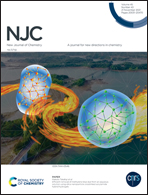Construction of Bi2MoO6/g-C3N4 heterostructures with enhanced visible light photocatalytic performance†
Abstract
To improve the separation efficiency of photogenerated carriers, heterogeneous photocatalysts were prepared and characterized in this work. First, graphitic carbon nitride (g-C3N4) and bismuth molybdate (Bi2MoO6) were synthesized by thermal polymerization and a hydrothermal method, respectively. Then, Bi2MoO6/g-C3N4 composites with different mass ratios were constructed by a facile method. The microstructure and morphology of the composites were characterized and analyzed. The results showed that Bi2MoO6/g-C3N4 heterostructures were formed in the composite. Taking rhodamine B as the target pollutant, the photo-degradation performances of the composite were evaluated. The experimental results indicated that the composite with a Bi2MoO6/g-C3N4 mass ratio of 0.1 : 0.9 exhibited excellent photocatalytic performance. The results demonstrated that the band structure of g-C3N4 and Bi2MoO6 can promote the migration of photogenerated carriers, and then reduce the recombination rate of photogenerated electrons and holes. In the photocatalytic process, superoxide free radicals played a major role.



 Please wait while we load your content...
Please wait while we load your content...